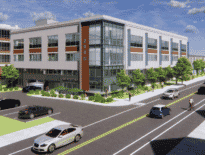As real estate development recovers from the pandemic pause and Boston-area architecture firms return to hiring mode, they’re finding a changed landscape for recruiting and retaining talent.
Some are feeling the effects of the great resignation, as experienced staff opt for early retirement or relocate out of state in what is traditionally a high-pressure industry with long hours. The pandemic has intensified a shortage of experienced mid-career staff, according to executives at local firms, and prompted some to consider hiring full-time remote employees for the first time and expand flexible work arrangements for all.
“This is totally a job-seeker’s market, and it will continue to be a job-seeker’s market for the next year,” said Kent Southard, chief financial officer at Boston-based CBT Architects. “The opportunity is real for architects and urban designers.”
CBT has hired 30 new employees in 2021, bringing its headcount in Boston to 200, and extended offers to another 10 hires in the last month as it scales up to compete for the continuing development boom in Greater Boston and other COVID-resilient real estate markets. People with 5 to 15 years’ experience in the industry are particularly hard to find and will have a strong advantage competing for positions, Southard said.
Perkins + Will initially took a cautious approach to its 2021 hiring plans, anticipating business conditions similar to 2020 with lingering uncertainty about how much the pandemic would disrupt the flow of building projects.
“Around halfway through the year, we were getting signs that things were picking up and that’s really been playing out for the last two months,” said Andrew Grote, director of operations and a principal in the firm’s Boston office. “It’s a big V [shaped recovery] with Jan. 1 at the bottom.”
Because Perkins + Will pursues work on a broad geographic scope, with 25 U.S. offices, it’s expecting a steady influx of new assignments in cities with active development pipelines from Boston to Seattle.

Architecture firms seeking to expand workforces and compete for an expected uptick in industry work are adapting to a labor market that’s reflecting COVID-induced changes and lingering effects of the 2009 financial crisis.
Billings Trend Upwards
Boston firms’ experience are being felt throughout the U.S. industry as billings trend upwards and companies scale up staffing, according to American Institute of Architects research.
A recent AIA survey says inquiries to firms about new projects remain near all-time highs, pointing to an anticipated uptick in firms’ billings. The industry saw a strong recovery in the first half of 2021 amid pent-up demand, and has recovered nearly all of the jobs lost during the first year of the pandemic, said Kermit Baker, AIA’s chief economist.
As they seek to grow, firms are facing similar challenges as other industries in finding enough qualified hires.
“Most firm principals I talk to indicate their staffing situation is much more dire than it was a year-and-a-half ago,” Baker said.
Workers ‘Reevaluating What’s Important’
Anecdotally, industry leaders point to several explanations, Baker said. Some employees who had been contemplating retirement accelerated their plans. Others fled high-cost coastal cities in 2020 for smaller metros or rural areas.
“Some of them have returned and some of them have not. What we have now is not a match between where the people are, and where the jobs are,” he said. “That’s a broader issue, but it’s also true for architecture.”
Some longtime employees at Boston-based architects and urban planners OverUnder departed in 2020 after reassessing career goals, Principal Rami el Samahy said.
“People have started to think about their home lives and decided to move onward and leave the state or do something else,” he said. “It’s based upon lifestyle changes and reevaluating what’s important, which I get.”
Retaining experienced staff has taken on new urgency in a job-hopping environment. The industry has been struggling for years to find mid-career professionals amid the lingering effects of the 2009 financial crisis, el Samahy said.
“It’s not hard to find young talented folks. It is hard to find the mid-level folks, because a lot of people left the profession during the last recession,” he said.

Steve Adams
Boston-based Utile Architecture & Planning is currently seeking to fill four positions, and Director of Research Cyrus Dahmubed sees a change in the past two months indicating that applicants are juggling multiple offers.
“We’re just noticing candidates are needing quick answers, and that’s something that feels a little bit different than pre-pandemic and last summer and winter,” he said.
Job-seekers’ leverage is prompting firms to tout flexible work arrangements and other perks.
With 25 offices across the U.S., Perkins + Will had allowed flexible work arrangements pre-COVID with most employees assigned to a nearby office. As it continues to hire this fall in its 140-employee Boston office, it’s offering more leeway to new hires, Grote said. Recent hires who missed finding an apartment by Boston’s big Sept. 1 lease rollover date will have the option of working 100 percent remotely through Jan. 1.
“We were flexible before about when you have to be in the studio, and that flexibility is an advantage for us,” Grote said.




 |
| 

